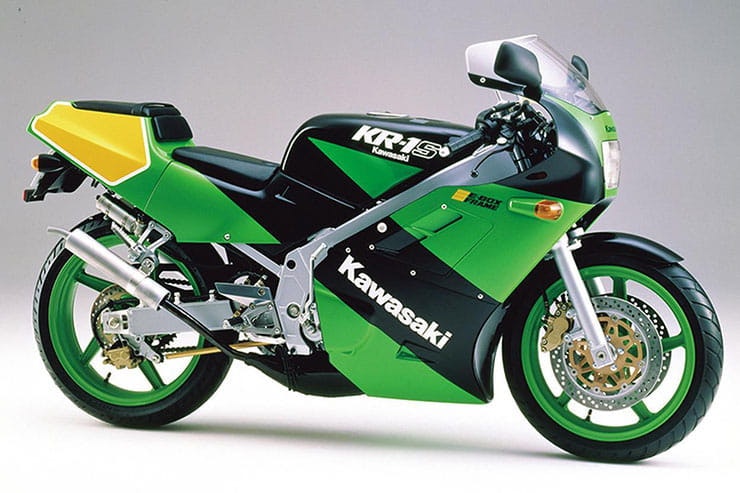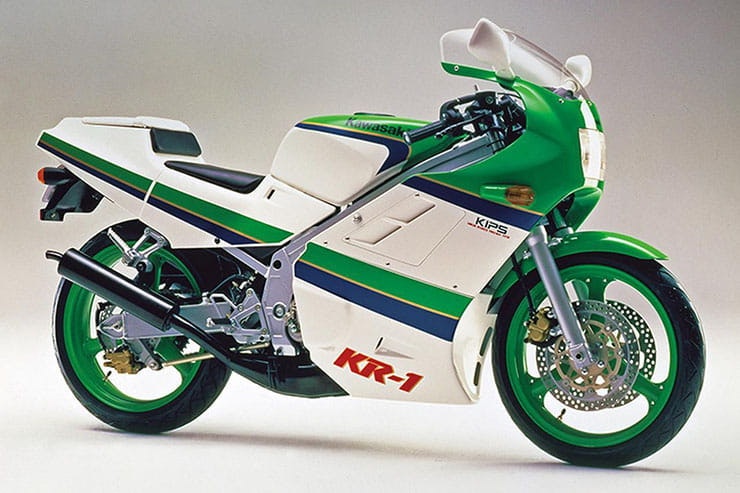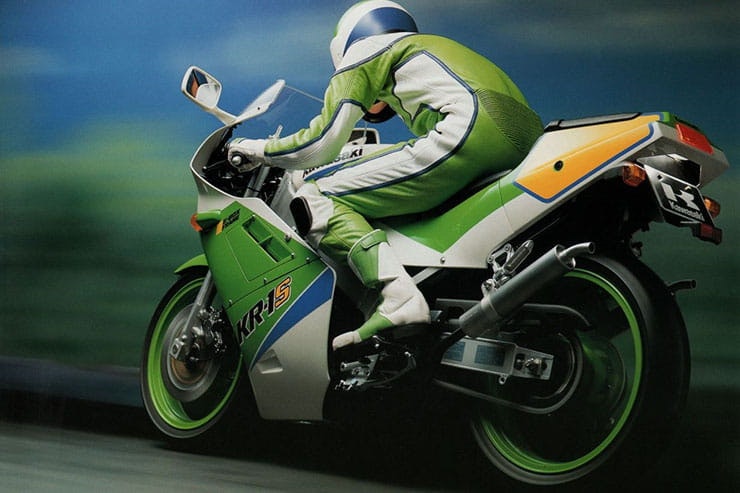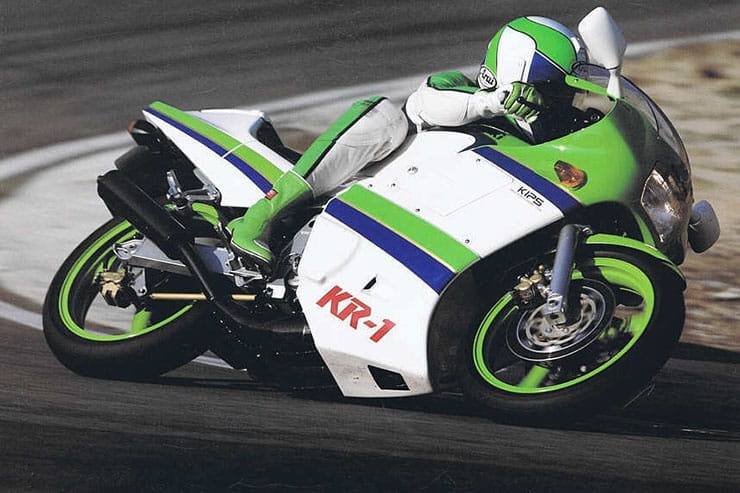Kawasaki KR-1/KR-1S (1989-1992): Review & Buying Guide
By Jim Moore
Bike journo for a quarter of a century
06.06.2023
Price: £5000-£9000 (KR-1S) | Power: 59bhp | Weight: 131kg | Overall BikeSocial Rating: 4/5
Kawasaki’s KR-1 and KR-1S are the fastest 250cc production two-stroke race replicas ever built, the former scorching to 131mph in 1989 and the latter topping 140mph in some magazine tests a year or so later. By comparison, Suzuki’s svelte RGV250 models could only manage 125mph and 127mph respectively. Even Aprilia’s exotic RS250s couldn’t get near the Kawasakis’ outright speed, so if you want the fastest 250 there’s still only one place to look.
As well as being considerably faster than anything else in class, both KRs were and still are hugely exciting to ride, although raw and edgy with it. If you want refinement, buy an NSR250 or an RGV250 VJ23. But if you want the most thrilling quarter-litre experience available, only a KR-1 or KR-1S will do.
There is a catch, however. All that speed comes at a price; these Kwaks can be as fragile as they are fast. Luckily most of their reported fragility issues can be traced to poor production and inaccurate machining at the factory, so it is possible to rectify the problems and drastically improve a KR’s reliability without losing performance.
An unrivalled top speed certainly helped KR-1/1Ss shift from the showroom floor onto the road – what 17-year-old wouldn’t want the fastest 250 available once they’d passed their test? This USP also caught the attention of many club racers, who could see the bikes’ potential at faster tracks against the sweeter handling RGV. Thirty years on that same potential comes with a ‘buyer beware’ warning, however. As two-stroke values have rocketed in recent years an inevitable influx into the market of ex-race machines masquerading as road bikes has occurred, as unscrupulous individuals look to make a tidy profit from worn-out scrap.
That said, it’s still fairly easy to track down tidy, well maintained KRs. When buying a bike like this, your attention should be as much on the owner as the bike. How they treat/run/ride a KR-1/1S will be a useful indicator as to how good the bike is. For example, ask what 2T oil and fuel they run – Super Unleaded and quality fully synthetic injector oil is the answer you’re looking for. Likewise, how often do they refresh the piston rings and pistons? Again every 4000 and 8000 miles respectively is a good answer.
Compared to an RGV, NSR, RS or TZR 3XV these Kawasakis feel crude to ride. The handling’s not quite as sharp, the finish isn’t as plush, the tech not as advanced, but the ergonomics are more generous, the wind protection is better, and the adrenaline rush unmatched. Be prepared for horrific fuel bills, however. Thrashed hard, a KR-1S will drain its tank in less than 80 miles, returning a wallet-bashing sub-25mpg…
Originality is key. If a motor’s been tuned, ask by whom, to what spec, and when. A stock spec engine will be more reliable. Some cheeky KR-1 owners have been known to get their bikes resprayed in KR-1S colours, even fitting the latter bike’s pipes, wheels and brakes – the frame is the give-away, however; true KR-1Ss have smooth beam sections on the chassis, the KR-1’s are channelled. Snare a good one though, and you’ll own the fastest, best value 2T race replica money can buy.
Still the fastest 250 production bike ever made
Hugely entertaining to ride
More spacious than an RGV or NSR
18in rear wheel limits tyre choice
Unreliability – particularly the KR-1
Getting harder to find original, nice nick examples
Kawasaki KR-1/KR-1S (1989-1992) Prices
The KR-1 was Kawasaki’s first liquid-cooled two-stroke parallel twin. The earlier KR250 was a tandem twin and shares no parts with these later machines. KR-1s are easy to spot due to their three-spoke wheels, black silencers, 280mm front discs and channelled frame spars. Colours are green/white/blue/gold and red/white/black/gold. Appeared in Japan in 1988; UK ’89 only. 55bhp, 123kg.
KR-1 values: Rough £2500-£3500; Tidy £4000-£5500; Mint £6000-£8000
Launched in 1990 in the UK – 1989 in Japan. Similar silhouette to the KR-1, but many differences, including smooth frame rails and swingarm, wider five-spoke wheels (up from 100/70 17 and 130/60 18 to 110/70 17 and 140/60 17), racier porting, new pipes with smaller aluminium silencers, bigger 300mm discs and new calipers, uprated suspension and new colours: green/black/yellow, green/white/blue/yellow, red/gun metal/white, blue/black (Japan only). 59bhp, 131kg.
KR-1S values: Rough £3000-£4500; Tidy £5000-£6500; Mint £7500-£9000
The KR-1R is a small volume Sports Production version of the KR-1S, produced to homologate the bike for TT-F3 racing in Japan – the only market in which it was sold. Max power is 45bhp, but the factory race kit takes output to near 70bhp. Differences to the KR-1S include a close-ratio gearbox, racier porting, stronger clutch, bigger 35mm carbs, and a different ignition. Only 200 were built, so they’re extremely rare. A locally sanctioned KR-IS/R hybrid was sold briefly in Australia – basically a 1S with bigger carbs and modded barrels/ignition, but you’re unlikely to find one here.
KR-1R values: Rough £8000-£9000; Tidy £10,000-£11,500; Mint £12,000-£18,000
Kawasaki KR-1/KR-1S (1989-1992) Engine and Performance
Kawasaki enjoyed considerable success in Grand Prix racing’s 250 and 350 classes during the late 1970s and early 1980s, winning both championships four times a piece between 1978 and 1982. The bikes, the KR250 and KR350, were tandem twins, with cylinders positioned one directly in front of the other. A 250cc road replica, also called the KR250 and aping the race bike’s rotary-valve induction and tandem layout, was launched in 1984. It sold for two years in Japan and Australia, but was quickly overshadowed by Honda’s NS250R and Yamaha’s TZR250.
The KR-1 was all new. First launched in Japan in 1988, it did away with the tandem engine layout, instead featuring a compact parallel-twin format, crankcase induction, and Kawasaki’s KIPS powervalve system that electronically opens and closes a chamber at the exhaust port to increase exhaust volume at low rpm for better torque, then closes it off at high rpm for maximum performance.
A cassette-type gearbox allowed racers access to the transmission without splitting the crankcases, while radical porting, 28mm carbs, and expansion chamber pipes gave the KR-1 a claimed output of 55bhp@10,500rpm. Performance was indeed brisk, but issues with failing ring pegs and poorly machined cylinders meant seizures were common on KR-1s and early KR-1Ss before Kawasaki finally addressed the piston issue; getting barrels decked by a tuning shop is the only way to irradicate seizures by poor machining from the factory.
Even though the KR-1 was the fastest 250 by a considerable margin, Kawasaki updated the engine for KR-1S duty, with improved and lighter pipes, different porting, and uprated pistons. The result was 4bhp extra and a top speed guaranteed to keep RGVs in the rear-view mirrors.
Kawasaki KR-1/KR-1S (1989-1992) Handling & Suspension
The KR-1’s chassis is very much of its time. The aluminium frame features massive beam sections (note the KR-1’s are channelled down their sides), a single-shock rear suspension set-up held in place by an equally chunky box-section swingarm, an almost nervous 24°/93mm rake/trail, lightweight hollow three-spoke wheels (17in front and 18in rear), all hauled up by a triple disc set-up. At just 123kg dry, a KR-1 will turn on a pin.
Unfortunately, the preload and rebound adjustable rear shock and similarly equipped 41mm forks weren’t the greatest even in 1988, offering crude damping and an often choppy ride on uneven surfaces – modern cartridge internals and a quality replacement shock are now the only way to go.
The KR-1S chassis got a radical overhaul. A new, stiffer, flush finished frame and swingarm set the stall, linked to a new remote reservoir shock, wider five-spoke wheels on radial tyres, bigger 300mm front discs and uprated Tokico calipers. Dry weight increased by 8 kilos, but overall, the KR-1S is the distinctly better bike, even if the ride quality isn’t that much better than its predecessor.
Kawasaki KR-1/KR-1S (1989-1992) What to look for
Pistons: A major issue with the KR-1 and 1Ss early on, but most bikes will be running replacement pistons by now. The problem was ring pegs breaking free, allowing the rings to spin in their grooves, eventually picking up on the exhaust port and seizing the engine. Later ART pistons cured the issue (SKE are the offending parts). Some owners fit single ring TZ pistons with additional lube ports either of the exhaust port. Refresh rings every 4000 miles, pistons every 8000 miles for peace of mind. Wossner pistons are £110.40 at pjme.co.uk.
Barrels: The machining of some KR-1 and 1S barrels was questionable from the factory, causing them to sit lop-sided on the crankcases. This led to pistons picking up and seizing. Barrels are interchangeable between models, but you’ll need 1S pipes and ignitor box if you looking to upgrade barrels on your KR-1.
Cranks: Individual parts are now hard to find, but 2T experts pjme.co.uk can offer a completely rebuilt KR crank with rods for £400. If you’re looking at a bike that’s stood idle for a while, crank seals can harden and perish, so price in a crank rebuild to your cost.
Balancer shaft: Racers liked to remove the balancer, but this can lead to further issues like cracked engine mounts due to increased vibes.
Carbs: Both models run Keihin PWK28 slide carbs as standard but beware the past attention of many a home tuner who’ll have experimented with bigger jets, different needle heights and binning the airbox. Modern fuel can wreak havoc on the internals too.
Exhausts: Big and heavy, particularly on the KR-1 (some owners fitted 1S pipes with slimmer cans), but if you want a minter, you’ll want stock exhausts. Aftermarket spannies can be good, but often need appropriate jetting and cylinder tuning to give their best.
Imports: Even though both the KR-1 and KR-1S were officially imported into the UK, some Japanese market grey imports have made it over too. J-spec bikes are restricted to 45bhp, comes with kph speedos and, in the case of the KR-1S, some different colours – notably blue. All KR-1Rs are imports.
Ex-race bikes: These Kawasaki twins were popular with club racers, so many were raced, some of which will have made their way back onto the road. Tell-tale signs of a track past are a tatty chassis/mint stock bodywork, drilled sump plugs, low mileage that doesn’t match the rolling stock’s condition, heavily chipped rims (from tyre changes), and super-zingy engines.
Kawasaki KR-1/KR-1S (1989-1992) Rivals
Honda NSR250R MC16/18, 1987-1989 | Approx Price: £4000-£6000 (MC16); £5000-£10,000 (MC18)
Power/Torque: 45bhp/26lb-ft | Weight: 125kg
NSRs were Japan only (here through grey import) so they’re restricted to 45bhp, but offer a decent spread of performance, ace handling a level of detail and sophistication the KR-1 and 1S can’t match. SP versions of the MC18 are most desirable, particularly the 1989 R5K with dry clutch.
Suzuki RGV250 VJ21/VJ22, 1989-1994 | Approx Price: £4500-£7000 (VJ21); £5000-£10,000 (VJ22)
Power/Torque: 55bhp/29lb-ft | Weight: 128kg
Direct competitor to the Kawasakis, especially as official imports. Haven’t got the outright speed or thrill of the KRs, but far more advanced in terms of design, technology and ride. Later VJ22 models are becoming particularly sought after.
Yamaha TZR250 2MA, 1986-1990 | Approx Price: £3500-£6000
Power/Torque: 49bhp/26.2lb-ft | Weight: 128kg
First model TZR is a conventional parallel twin, like the Kawasaki. Light, fun and handles well – also far more reliable than the Kawasakis. Some owners have seen up to 20,000 miles on original pistons. Japanese import 1KT and 2XT models also available – the latter has a wider rear tyre, different porting and revised rear suspension.
Kawasaki KR-1/KR-1S (1989-1994) Verdict
The KR-1 and KR-1S’s draw is obvious; their USP has been the same since they were launched more than 30 years ago. And 130mph is still an impressive top speed for just 250cc. Kawasaki has always put performance first, creating its reputation through a series of rapid yet often flawed machines, from the original Z1, H1 and H2 through the Turbo and GPz years to the various incarnations of ZX-10R. The KRs are very much part of that line.
A decent KR is still a great thrill to ride, but it’s critical to buy a good one. A half-arsed example or something rough will give endless trouble. A KR should be crisp, keen and sharp as a razor – the one without the lubricating strip, obviously. These Kawasakis make sense in terms of their size, too. A lot of 250 race reps, like the NSR and RGV are tiny – way too small for your average middle-aged enthusiast. But the KR-1/1S offer a package that’s that bit more accommodating, yet still bonkers. We love ’em.
Kawasaki KR-1S (1990) – Technical Specification
Looking for motorcycle insurance? Get a quote for this motorbike with Bennetts bike insurance



